Or not. Climate science has a few rules but a lot of exceptions and 700,000 years ago a big exception occurred. At that time the planet experienced a “warm ice age” and it permanently changed the climate cycles on Earth. Though it became warmer and with more rain, the polar glaciers also expanded. Geological data in combination with computer simulations published in Nature Communications hopes to lend insight into this paradox.
Glacial periods – ice ages -are characterized by the development of large ice sheets in the Northern Hemisphere. As Neandertal-Denisovan ancestors of modern humans were spreading across the globe, these phases began to shift between distinct glacial and warm periods about every 100,000 years.

Long-term expansion of Mediterranean forests and increase in precipitation as well as an enhanced East Asian summer monsoon associated with the increase and northward migration of the Atlantic moisture source. Paradoxically, the glacial was warmer and wetter than the preceding interglacial. Credit: André Bahr
Prior to that, the Earth’s climate was governed by 40,000-year cycles with shorter and weaker glacial periods. The change in the climate cycles occurred in the Middle Pleistocene Transition period, which began approximately 1.2 million years ago and ended about 670,000 years ago.
Why the shift? Early humans certainly were not impacting the climate in any meaningful way but the mechanisms responsible for this critical change in the global climate rhythm remain largely unknown. They're not variations in the orbital parameters governing the Earth’s climate but the recently identified ‘warm ice age’, which caused the accumulation of excess continental ice may hold clues.
For their investigations, the researchers used new climate records from a drill core off Portugal and loess records from the Chinese Plateau. The data was then fed into computer simulations. The models show a long-term warming and wetting trend in both subtropical regions for the past 800,000 to 670,000 years. Contemporaneous with this last ice age in the Middle Pleistocene Transition period, the sea surface temperatures in the North Atlantic and tropical North Pacific were warmer than in the preceding interglacial, the phase between the two ice ages.
This led to higher moisture production and rainfall in Southwest Europe, the expansion of Mediterranean forests, and an enhanced summer monsoon in East Asia. The moisture also reached the polar regions where it contributed to the expansion of the Northern Eurasian ice sheets. “They persisted for some time and heralded in the phase of sustained and far-reaching ice-age glaciation that lasted until the late Pleistocene.
Such expansion of the continental glaciers was necessary to trigger the shift from the 40,000-year cycles to the 100,000-year cycles we experience today, which was critical for the Earth’s later climate evolution.
Citation: M. F. Sánchez Goñi, T. Extier, J. M. Polanco-Martínez, C. Zorzi, T. Rodrigues, A. Bahr: Moist and warm conditions in Eurasia during the last glacial of the Middle Pleistocene Transition. Nature Communications (published online 10 Mai 2023); DOI: 10.1038/s41467-023-38337-4





Comments